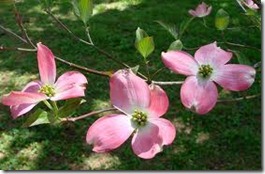Classified as a multiple-branched shrub and ornamental tree, flowering dogwood is native to most of the eastern United States. In the wild, you can find dogwood shrubs growing under pine trees or at the edges of a forest with other deciduous trees. The leaves of the flowering dogwood that fall to the ground decompose quicker than other species of trees and shrubs, producing organic matter that improves the soil. Humans should never consume the fruit of this shrub because it is poisonous to them, states a warning from the U.S. Department of Agriculture, Natural Resources Conservation Service (NRCS).
Appearance
-
Flowering dogwood is a popular ornamental tree-like shrub in the eastern United States according to floridata.com. Its average height is 15 to 25 feet and 15 to 20 feet across. The flowers are pink and white with four petals that look like someone painted them with a paintbrush. They bloom between March and June, lasting two to four weeks. The leaves of the flowering dogwood are deep green in the summer, turning a reddish purple to scarlet color in the fall. Bright red, football shaped fruit appear in the fall and ripens in September and October.
Growing Preferences
-
Dogwood shrubs thrive in an area with partial shade. Full sun or deep shade may cause the flowering dogwood to have poor growth and produce fewer blooms. The soil should be moist and well drained with a pH of 5.2 to 6.0, which is slightly acidic. These shrubs do best in a loamy soil with a high concentration of organic matter worked into it.
Care
-
Stress from lack of water or the wrong kind of soil makes the flowering dogwood shrub susceptible to disease. A regular maintenance schedule keeps it healthy. The dogwood shrub needs 1 inch of water per week during the growing season from natural rainfall or watering by hand. Over watering may cause decay or hurt root growth. Prune dogwood shrubs in the winter, during the dormant season, only if they have diseased, dead, insect-infected or injured branches. Begin fertilizing in the spring and fall with fertilizer used for azaleas and camellias. Mulching will prevent weed growth and help keep the soil moist. Spread 3 to 4 inches of organic mulch in an 8 to 10-foot radius, keeping the mulch 3 to 4 inches away from the base of the shrub.
Pests and Diseases
-
Dogwood blight is a fungal disease that appears on the leaves as small spots with purple edges. These can kill an infected shrub in two to three years. Anthracnose infects trees and shrubs in cool weather when it is moist. Plant flowering dogwood shrubs in an area with sufficient sunlight and good air circulation. In wet weather, diseases such as phytophthora leaf blight, powdery mildew and cankers may infect flowering dogwood shrubs. Dead tips of young twigs on dogwoods are from twig borers.
Uses
-
Flowering dogwoods attract animals and birds, drawn to the shrub for the seeds, sprouts and leaves. Small mammals and birds use this shrub for shelter as well as food. Native Americans found uses for the bark and roots. They dried the bark and ground it up or boiled it in water to make a tea, given to treat mouth problems, headache, diarrhea, muscle inflammation and reduce fevers. A red dye extracted from the roots and bark colored eagle feather and porcupine quills. The flowers boiled in water relieved colic pain in infants and reduced fevers in the sick.


Deprecated: strpos(): Passing null to parameter #1 ($haystack) of type string is deprecated in /home/agriviek8Qv/agriviet.net/public_html/wp-includes/comment-template.php on line 2522